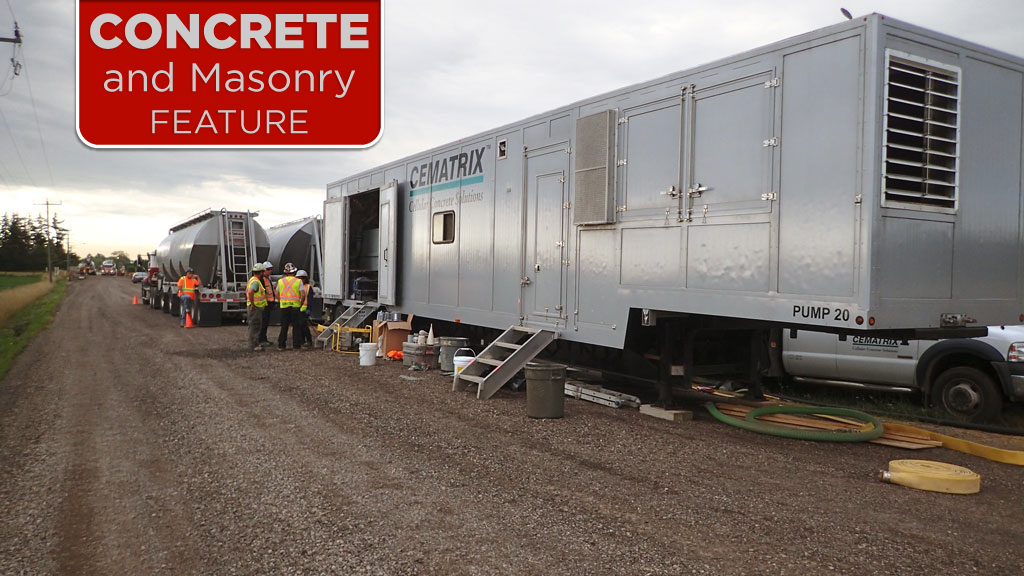Jeff Kendrick, president and CEO of Calgary-based Cematrix, spends a lot of time talking to engineers and professionals in the construction industry about the growing applications for his company’s product cellular concrete, one he describe more aptly as “foam cement”.
Cellular concrete does not use the aggregate found in concrete. Cematrix uses Portland cement, water, a specialized pre-formed foaming agent and compressed air. The cement-water slurry is mixed with the foaming agent having the consistency of a shaving cream, said Kendrick said. The foam’s microscopic bubbles do not dissipate in the slurry and as the mixture hardens produces a product that is lighter than water, has easy flow characteristics, insulates and has geotechnical strengths. Depending on the mixture, it can be produced in weights that are one-sixth to one-half that of concrete.
Despite being around for years, it is still relatively unknown product and education is a big part of ensuring company growth, Kendrick said. Company members go into firms and project offices to provide engineers with the full scope of the specialty product use, attend lunch and learn sessions, and have a resident engineer on hand to help with the design process.
“If they don’t know about cellular concrete, they can’t specify how to use it,” said Kendrick. The company also participates in research and development projects with universities and organizations.
The U.S. market is more familiar with the product and has a longer, more diverse history of the Canadian market. “They are about 10 years ahead of us (in Canada),” he said.
But, the growth market in both countries is infrastructure projects where roads, bridges, pipelines, utility companies, and resource users such as the oil and gas industry have been eager adapters of the product. Easy to pour and ability to flow, allows it to backfill bridge abutments, wrap around utility pipes in tunnels, and stabilize pipelines, said Kendrick. The product has also been used for insulating refinery slabs, frost protect shallow foundations, heated slabs and also thermal remediation of contaminated sites.
In the U.S., cellular concrete has a history of use in seismic or geotechnical applications where stabilizing ground in the event of an earthquake is a priority with California a prime market. Its’ growing popularity lies in the ability to create a floating substructure that it is lighter than water and can be engineered to carry the weight of load resting upon it.
“If the soil should liquefy and fall apart and if you have a cellular concrete base that can float and carry the weight, it should keep the structure in place,” he said, with proper engineering. It is being used on highways, runways, and in residential areas where soil conditions are weak or unstable. Cellular concrete has also been used to absorb shock in buildings from earthquakes.
Cematrix subsidiary Pacific International Grout worked on B.C.’s Metro Vancouver Port Mann Water Supply Tunnel built to withstand an earthquake as it burrows under the Fraser River. Pacific International Grout Company placed 6,000 cubic yards of specially engineered seismic cellular concrete to protect the one kilometer water line for its 100 year life including experiencing a major earthquake.
The growth potential in infrastructure and seismic or geotechnical applications caused Cematrix to step into the U.S. market. “In the past three years, we have acquired two of the four leading cellular concrete suppliers in the US,” he said as the company acquired Pacific International and a second company MixOnSite, while growing the Canadian market with operations in Vancouver, Winnipeg and Toronto. The company also has a joint- marketing agreement in place with Lafarge and a regional expansion agreement enabling both companies to expand cellular concrete markets in locations where Cematrix doesn’t have a presence.
The name cellular concrete is more of a misnomer and Kendrick pointed out that it is not a concrete and it does not compete with regular or lightweight concrete which mixes aggregates with cement.
“It is really comparable to Styrofoam,” he said and on infrastructure projects is grabbing up chunks of the EPS geofoam blocks and insulation markets as well as providing an alternative to regular back-fill.
“It has much better properties than Styrofoam,” he said, as it can provide enhanced strength, is less susceptible to degrade, and can be more stable.
“Usually when there is a better product, it costs more,” he said, but cellular concrete can be a better option price wise than geofoam or polystyrene products.
Cematrix has developed two delivery methods, Kendrick said, adding that cement slurry is brought to the Cematrix plant and as it is put into a Cematrix truck, a line injects the foam before it is trucked to the customer. On larger projects, he said, Cematrix has its own mobile units that can mix the cement slurry on site and inject the foam. Cematrix mobile production units can produce from 20 to 150 cubic metres per hour of cellular concrete.
Cematrix started in Calgary in the 1999 when Kendrick and a partner engineer both took $15,000 and founded a company that looked to expand the use of cellular concrete which has been around for decades but under-utilized and also develop new technologies for its use. Since that time the $30,000 private company has grown into a public multi-million North American leader in specialized cellular concrete applications.




Recent Comments